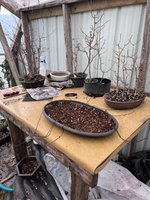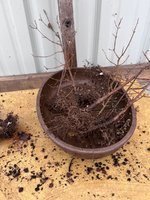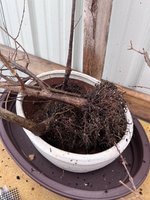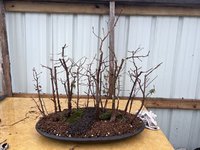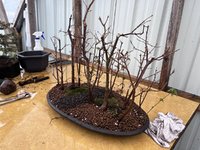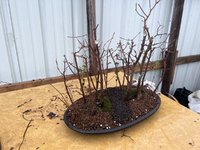You are using an out of date browser. It may not display this or other websites correctly.
You should upgrade or use an alternative browser.
You should upgrade or use an alternative browser.
My first forest
- Thread starter Rod
- Start date
Michael P
Omono
Excellent first forest! What species did you use?
Gabler
Masterpiece
You should try out the spare change method of spacing out your trees. You toss a handful of coins into the pot and place trees where the coins fall. A real forest is more or less randomly spaced out, and it's very difficult for humans to space things out unevenly. Using coins makes it genuinely random.
Michael P
Omono
I think the spacing of the trees is quite good as is the variation in trunk size.
Gabler
Masterpiece
I hope I don't come across as too critical, but since you asked for feedback, I should also mention the trees in the front all seem to be in a straight line.
Like I said, it's hard to get it to look just right. I'm not claiming to be much better at it.
Like I said, it's hard to get it to look just right. I'm not claiming to be much better at it.
Bonsai Forest
Omono
this makes perfect senseYou should try out the spare change method of spacing out your trees. You toss a handful of coins into the pot and place trees where the coins fall. A real forest is more or less randomly spaced out, and it's very difficult for humans to space things out unevenly. Using coins makes it genuinely random.
Eckhoffw
Masterpiece
successfully arranging a forest to look natural comes with practice- much like floral arrangement. It’s just about knowing what works.
I am sorry but for me there is so much more to placing trees in a group planting than randomness...this is nonsense advice and a faulty notion....there is no correlation between natural forests and bonsai group plantings...a quality group planting is purposefully designed to offer the viewer an experience with perspective, movement, and hopefully emotion...no different than what we hope to capture with an individual tree. This advice is on par with the long taught belief that you make group plantings from trees too ugly to make individual bonsai.You should try out the spare change method of spacing out your trees. You toss a handful of coins into the pot and place trees where the coins fall. A real forest is more or less randomly spaced out, and it's very difficult for humans to space things out unevenly. Using coins makes it genuinely random.
Well done for a first effort!
a couple points to consider for your next effort...
1. Look at the trees that make up the front row in your planting....they are pretty evenly spaced across the front...next try placing some of the trees in pairs or trios with the trunks very close together and try to not have the front on a flat vertical plane...bring some trees more forward..
2. To add some more perspective...have the path narrow and turn as it moves to the back... avoid the open space at the end of the path by having it turn and disappear behind a group of trees (maybe your does turn at the end but its difficult to see from the photo)
3. you have designed what I call a near view forest...in this model, the larger trees are placed at the front of the composition. The remaining trees are placed behind and get progressively smaller as they move toward the back of the composition. My preference for near view is to have a greater variation in tree size...a much larger number one and/or number two tree seem to really help improve the effect...
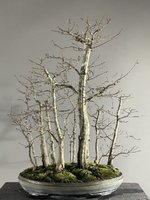
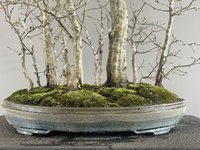
a couple points to consider for your next effort...
1. Look at the trees that make up the front row in your planting....they are pretty evenly spaced across the front...next try placing some of the trees in pairs or trios with the trunks very close together and try to not have the front on a flat vertical plane...bring some trees more forward..
2. To add some more perspective...have the path narrow and turn as it moves to the back... avoid the open space at the end of the path by having it turn and disappear behind a group of trees (maybe your does turn at the end but its difficult to see from the photo)
3. you have designed what I call a near view forest...in this model, the larger trees are placed at the front of the composition. The remaining trees are placed behind and get progressively smaller as they move toward the back of the composition. My preference for near view is to have a greater variation in tree size...a much larger number one and/or number two tree seem to really help improve the effect...


rockm
Spuds Moyogi
Exactly. Bonsai is anything but random. It's intentional and meant to serve the viewer. nature and chance don't do that. The mistake people make is assuming bonsai is meant to recreate "natural" spaces. While that is only PART of what it does and it's not a primary goal. The primary goal is to communicate to people using techniques that maximize that viewing. In a forest, that means emphasizing perspective using larger trees as anchors and smaller ones as supporting members to create a scene that LOOKS natural to people, but in fact is a planned composition that elicits that perspective. Painting a picture of a forest on canvas isn't just applying pigments to a board. The artist emphasizes certain aspects of what they're seeing and uses techniques to enhance the scene.I am sorry but for me there is so much more to placing trees in a group planting than randomness...this is nonsense advice and a faulty notion....there is no correlation between natural forests and bonsai group plantings...a quality group planting is purposefully designed to offer the viewer an experience with perspective, movement, and hopefully emotion...no different than what we hope to capture with an individual tree. This advice is on par with the long taught belief that you make group plantings from trees too ugly to make individual bonsai.
Thank you. Trident maples.Excellent first forest! What species did you use?
penumbra
Imperial Masterpiece
A thoughtful discussion here, both insightful and inciteful. Certainly it is more than a random act.
BTW, I like what you have done, but 100 people could look at it and see 300 ways to do it.
BTW, I like what you have done, but 100 people could look at it and see 300 ways to do it.
Cajunrider
Imperial Masterpiece
The most important things I have learned regarding forming bonsai forest is having a vision of the forest in my mind then determining where I want to set my vanishing point(s) to create the perspective of a forest while dealing with my limitations in space, number and size of trees. Once I have that understanding, I look back and see the busts that my current forests areWell done for a first effort!
a couple points to consider for your next effort...
1. Look at the trees that make up the front row in your planting....they are pretty evenly spaced across the front...next try placing some of the trees in pairs or trios with the trunks very close together and try to not have the front on a flat vertical plane...bring some trees more forward..
2. To add some more perspective...have the path narrow and turn as it moves to the back... avoid the open space at the end of the path by having it turn and disappear behind a group of trees (maybe your does turn at the end but its difficult to see from the photo)
3. you have designed what I call a near view forest...in this model, the larger trees are placed at the front of the composition. The remaining trees are placed behind and get progressively smaller as they move toward the back of the composition. My preference for near view is to have a greater variation in tree size...a much larger number one and/or number two tree seem to really help improve the effect...
View attachment 536378
View attachment 536379
Last edited:
rockm
Spuds Moyogi
This composition is in the National Bonsai and Penjing Museum. It is a very well done forest using forced perspective, emphasizing larger trees with smaller trees supporting them in the background to force the viewer to see the smaller as more distant. It's only one way of doing a forest, obviously. John G's forest is more of an "up close" composition but uses some of that forced perspective.
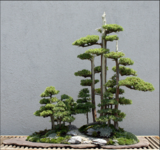

Last edited:
Gabler
Masterpiece
I am sorry but for me there is so much more to placing trees in a group planting than randomness...this is nonsense advice and a faulty notion....there is no correlation between natural forests and bonsai group plantings...a quality group planting is purposefully designed to offer the viewer an experience with perspective, movement, and hopefully emotion...no different than what we hope to capture with an individual tree. This advice is on par with the long taught belief that you make group plantings from trees too ugly to make individual bonsai.
Exactly. Bonsai is anything but random. It's intentional and meant to serve the viewer. nature and chance don't do that. The mistake people make is assuming bonsai is meant to recreate "natural" spaces. While that is only PART of what it does and it's not a primary goal. The primary goal is to communicate to people using techniques that maximize that viewing. In a forest, that means emphasizing perspective using larger trees as anchors and smaller ones as supporting members to create a scene that LOOKS natural to people, but in fact is a planned composition that elicits that perspective. Painting a picture of a forest on canvas isn't just applying pigments to a board. The artist emphasizes certain aspects of what they're seeing and uses techniques to enhance the scene.
I'm not sure I see why to two approaches are mutually exclusive—and I mean that as a genuine question. Why not use the coin method as a starting point to avoid geometric patterns and then create an inviting space from there? I don't know that I've ever seen it used strictly. It's one tool in the toolbox. Is it a tool I should discard completely?
that is completely up to you and depends on the quality of the groups you desire to make...I'm not sure I see why to two approaches are mutually exclusive—and I mean that as a genuine question. Why not use the coin method as a starting point to avoid geometric patterns and then create an inviting space from there? I don't know that I've ever seen it used strictly. It's one tool in the toolbox. Is it a tool I should discard completely?
Gabler
Masterpiece
that is completely up to you and depends on the quality of the groups you desire to make...
I take it that if my goal is to build the absolute highest possible quality of forests, then I should ditch the coin method?
rockm
Spuds Moyogi
The thing is you're NOT trying to avoid geometric patterns. You are SEEKING THEM OUT, interlocking triangles, etc. that emphasize the composition. You're trying to avoid CONTRIVED geometric patterns that jar the eye--linear placement being a primary offender. And BTW--linear placements wind up in coin toss assignment as well. You're leaving that to chance with simply randomly assigning (limited) spaces in a bonsai pot. Every inch is valuable and best not left to chance.I'm not sure I see why to two approaches are mutually exclusive—and I mean that as a genuine question. Why not use the coin method as a starting point to avoid geometric patterns and then create an inviting space from there? I don't know that I've ever seen it used strictly. It's one tool in the toolbox. Is it a tool I should discard completely?
The coin don't have no say...It's just you
rockm
Spuds Moyogi
This sounds like some kind of bait and "aha gotcha" You may have some expert saying that's how they do things. They may and it might even work occasionally (randomly). I'll take the bait. Yeah, I would ditch that method and learn to rely on my eye and the trees in front of me than to leave it to chance.I take it that if my goal is to build the absolute highest possible quality of forests, then I should ditch the coin method?
Similar threads
- Replies
- 2
- Views
- 158
- Replies
- 1
- Views
- 189

